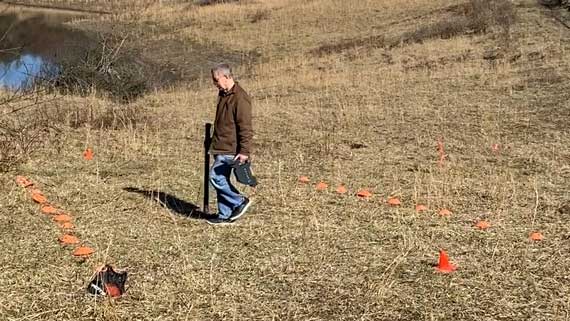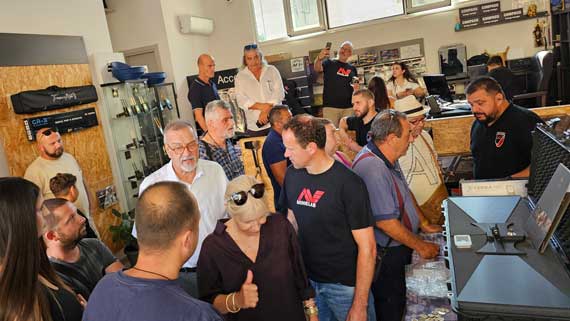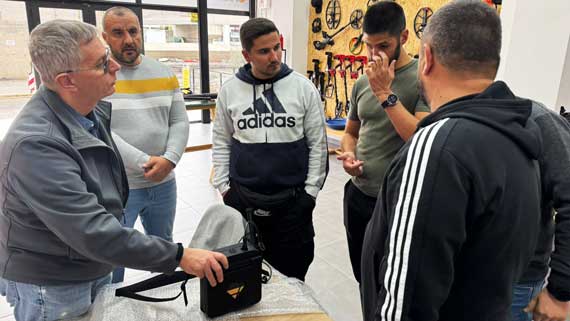Real-World Testing: Scans with OKM Detectors on Historical Site
Innovation Meets History: OKM Field Deployment at the Castle
In June, the OKM team visited an old castle in Thuringia, Germany, to test our latest technologies and existing detectors in a unique environment with a rich past and a mission shaped by the future. Our engineers, support staff, and OKM’s CEO, Stephan Grund, and CTO, Christian Becker, joined the field team. All were united by one goal: to continue developing our detectors under real-world conditions.
After a warm welcome from the team at the old castle and a short guided tour of the historical site, we began our measurements. This field test was especially exciting because it contrasted with our usual test fields, where buried objects are placed in controlled conditions. Here, the terrain is natural and undisturbed, presenting all the real-world complexity and challenges.
We took this opportunity to test our existing detectors, which helped us identify areas for improvement. Additionally, we deployed new prototypes that are still under development — stay tuned for more in August!

Same Field, Different Detectors, Many Signals
We scanned the same area using several OKM detectors. All scans showed identical anomalies in the same positions. This consistency suggests the presence of possible buried objects and remains of foundations, likely linked to the original structure of the old castle. A promising result that confirms both the reliability of our detectors and the historical value of the site.

We set up our first scan field where the south wing of the castle once stood. The scan field, with a length of 22 m (72 ft) and a width of 8 m (26 ft), was perfect for initial comparative scans with several detectors.
The first scan with the OKM Fusion Light already revealed smaller signals. Those in the lower part were afterwards checked with VLF detectors and the detected metallic objects were dug up. The cluster of signals at the top is particularly noteworthy.

We scanned the same field with the OKM Rover C4 with Super Sensor. In a detailed comparison with the Fusion Light scan, a higher resolution is clearly visible, which means that even smaller target objects could be detected better.
Here, too, smaller isolated signals can be recognized in the lower area (blue and green dots as well as red and blue signature combined in the middle). At the top edge of the scan image, the structure of a larger object is already more distinct.


When using the OKM eXp 5500 with the SenseSystem — five sensor pairs simultaneously — and another scan with the single Super Sensor, the previously detected objects are also clearly visible.
The scan result with the SenseSystem makes scan evaluation even easier thanks to an even more precise detection of signals – and performing the measurement was also much more time-efficient.
All four scans revealed particularly prominent clusters of signals at the upper edge. Due to this result, an additional scan field was set up.
When comparing all three 3D ground scanners, it becomes clear that Fusion Light detects target objects very well, but the Super Sensors used with Rover C4 and eXp 5500 detect anomalies more accurately. Maximum accuracy can currently be achieved with the eXp 5500 Pro using the entire SuperSense System, i.e., five Super Sensors simultaneously.
A more detailed comparison of the eXp 5500 scan with single Super Sensor and the Rover C4 scan, also performed with Super Sensor, shows once again how accurately the Super Sensor works when used individually, independently of the 3D ground scanner.
Verifying the Detected Potential Target Objects


After detecting anomalies at the upper edge of the first scan field, we adjusted the scan area, placing the suspected structure in the center of the new field. Follow-up scans using the OKM Fusion Light and the OKM eXp 5500 confirmed the anomalies – the latter in higher resolution –, strengthening the assumption of potential underground structures at that location.
Since this was our first visit to the castle, our focus was on scanning and mapping the entire area. We did not excavate the anomaly at this stage. As the collaboration continues, we plan to return and carry out a targeted excavation to find out what lies beneath.
What’s down there? We’re eager to find out for you!


Young Hands for the old castle – Living Monument Preservation
One of the highlights of our visit was meeting three dedicated young adults who are currently completing their Freiwilliges Soziales Jahr (Voluntary Social Year) in monument preservation as part of the Mobile Jugendbauhütte program. Starting in September 2024, the castle will officially serve as a placement site for this nationwide initiative.
The Jugendbauhütten (Youth Building Lodges) offer young people the opportunity to learn traditional craftsmanship and conservation skills through hands-on training at historical monuments guided by experienced professionals. Thus, the castle is reconnecting with its long educational legacy. As early as the Baroque era, craftspeople were supported here through scholarships. Now, this spirit of heritage and learning is being revived.
Curiosity Meets Technology: Youth Program Explores OKM
The FSJ participants were eager to explore the world of treasure hunting. They gained hands-on experience with our OKM Rover UC and VLF detectors, successfully locating their first small finds — a fun and meaningful introduction to the high-tech engineering behind our systems. Our engineers explained how detection, signal processing, and depth analysis work in practice.
In return, the young participants shared insights into their daily work at the castle and their role in preserving cultural heritage. The exchange was inspiring — curiosity for technology met passion for craftsmanship, and modern innovation encountered historical context. It was a valuable reminder of the importance of interdisciplinary learning.



Conclusion: Progress Starts in the Field
Our day at the old castle clearly demonstrated the importance of real-world testing for advancing our technologies. The fieldwork was a success. Our detectors performed well in natural conditions, and we gained valuable insights into areas for improvement. These findings will directly inform our development process, helping us to make our detectors more intuitive for users and refine future innovations for practical use.
At the same time, the visit reminded us of the importance of places like the castle as spaces for learning and discovery, especially for the next generation. From detecting the traces of old structures to exchanging ideas with young monument preservationists, the experience was a resounding success.
We extend our sincere thanks to the team at the castle for their hospitality – and to the young hands of the Jugendbauhütte for their enthusiasm and curiosity. We look forward to working together again in the future.





